Oxman
Well-known member
- Joined
- Jun 5, 2014
- Messages
- 161
- Reaction score
- 0
My tobacco world – Growing tobacco
Tobacco is actually a pretty easy plant to grow, it’s a bit of a weed, but what is more difficult is to grow a quality plant.
Sickly looking Virginia!
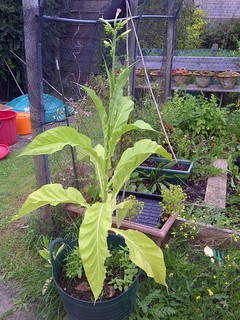
IMG-20110907-00038 by oxmanonline, on Flickr
I have grown my own tobacco a couple of times and in fact, this year I have planted Virginia, Dark Fired and Oriental. I have not grown DF and OR before so that should be interesting. I am going to have to build myself a little curing shed this year with heating and a smoker!
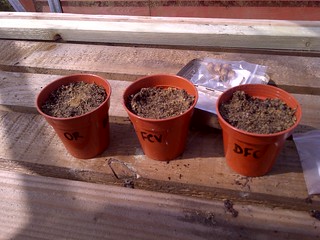
IMG-20140424-02107 by oxmanonline, on Flickr
There are approximately 60 million tobacco growers in the world, more than half of these are in China. Approximately 6 million are directly contracted by tobacco merchants, the rest either sell on the open market or through auctions. Approximately 85% of tobacco is grown by small scale farmers with an average of 1 acre (1/2 Ha) of tobacco.
Tobacco is known as a 9 month crop – 3 months to produce the seedlings before transplanting, 3 months to grow a mature plant from transplanting and 3 months of harvesting.
Seedbeds and growing:
Tobacco seeds are absolutely tiny, a couple of grams are plenty for an acre (1/2 Ha)! The seed pods each contain thousands of little seeds.
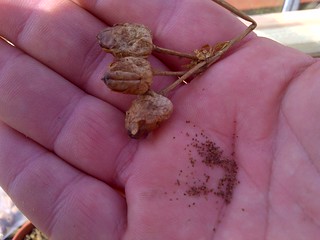
IMG-20140424-02109 by oxmanonline, on Flickr
Classically the seeds will be mixed with sand and then spread on a seedbed which is then covered to retain warmth and moisture. Some farmers will sow these into a small mother-bed and then transplant the tiny seedlings into trays, but others will just use long seedbeds.
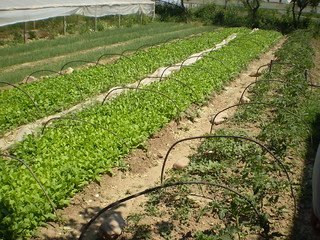
P5150021 by oxmanonline, on Flickr
More modern farmers will use pelletised seeds (seeds coated in a mixture of fertiliser and growth hormone). Pellet seed can planted directly into seedling trays.
In some countries the seedbeds will be grown and managed by individual farmers, but in others, they will join together and have communal seedbeds.
Commercial farmers will have far more sophisticated seedbeds with floating trays and permanent structures.
Commercial seedbed in China
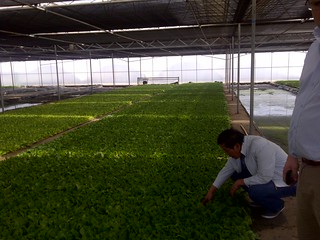
IMG-20120430-01073 by oxmanonline, on Flickr
Seedlings are key to a good crop so will be managed very carefully. The vast majority of pesticides and fungicides used in tobacco are applied at this stage.
When the seedlings have matured, the tops of the leaves will be clipped off and the watering will be reduced – this hardens off the stem and improves the roots. The seedlings are now ready for transplanting.
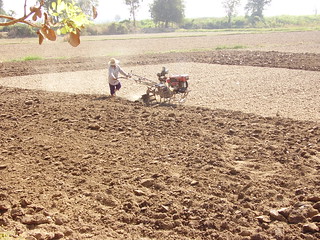
cultivating thai style by oxmanonline, on Flickr
Transplanting is mostly done by hand, seedlings are planted into ridges with a healthy dose of water, usually with a drench of pesticide to protect the new plants.
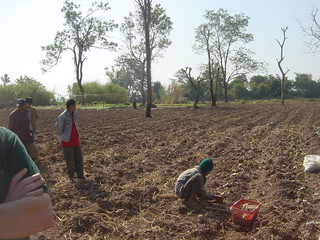
DSC01491 by oxmanonline, on Flickr
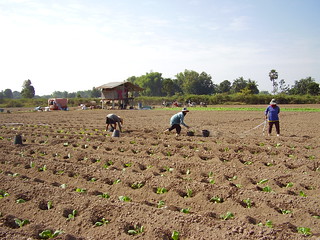
transplanting in thailand by oxmanonline, on Flickr
Commercial burley and FCV farmers and all Oriental farmers will use a planting machine on the back of a tractor.
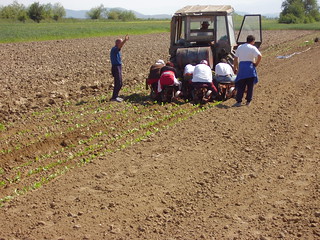
P1180035 by oxmanonline, on Flickr
A newly planted field can look like the seedlings are never going to make it, but it’s a tough plant and within a couple of weeks there will generally be strong healthy plants.
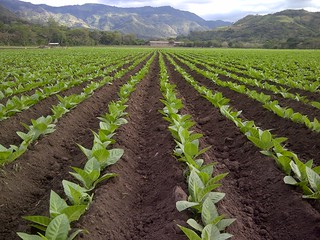
IMG-20140122-00467 by oxmanonline, on Flickr
The tobacco needs to be maintained through the growth period, making sure there are no pests and diseases, and providing water wherever possible.
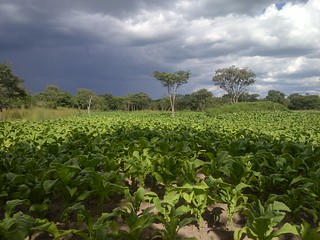
IMG-20130301-00067 by oxmanonline, on Flickr
One of the most important things is to remove the flower heads and suckers from tobacco (except on Oriental) – this allows the plant to use more energy on growing the leaves. Commercial tobacco farmers use a machine for this but everyone else does it by hand!
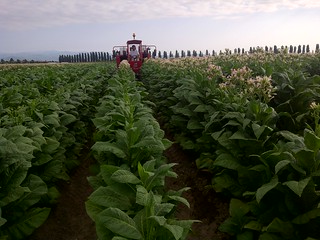
motorised topping machine by oxmanonline, on Flickr
Once the leaves are matured, the farmer will begin to harvest. With most crops except stalk cut burley, the leaves will be reaped from the bottom of the plant over a 2-3 month period, taking 2-3 leaves a week.
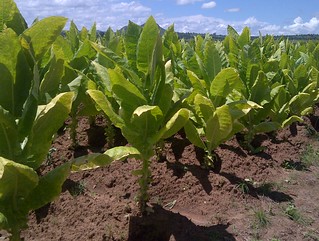
IMG-20130306-00158 by oxmanonline, on Flickr
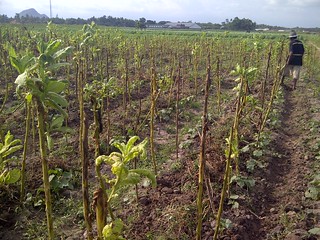
IMG-20130921-00113 by oxmanonline, on Flickr
This is one of the most skilled jobs, a poorly harvested leaf, whether it be too early, too late or damaged, will never be able to produce a top quality tobacco leaf for sale.
I will cover harvesting and curing in my next installment!
Tobacco is actually a pretty easy plant to grow, it’s a bit of a weed, but what is more difficult is to grow a quality plant.
Sickly looking Virginia!

IMG-20110907-00038 by oxmanonline, on Flickr
I have grown my own tobacco a couple of times and in fact, this year I have planted Virginia, Dark Fired and Oriental. I have not grown DF and OR before so that should be interesting. I am going to have to build myself a little curing shed this year with heating and a smoker!

IMG-20140424-02107 by oxmanonline, on Flickr
There are approximately 60 million tobacco growers in the world, more than half of these are in China. Approximately 6 million are directly contracted by tobacco merchants, the rest either sell on the open market or through auctions. Approximately 85% of tobacco is grown by small scale farmers with an average of 1 acre (1/2 Ha) of tobacco.
Tobacco is known as a 9 month crop – 3 months to produce the seedlings before transplanting, 3 months to grow a mature plant from transplanting and 3 months of harvesting.
Seedbeds and growing:
Tobacco seeds are absolutely tiny, a couple of grams are plenty for an acre (1/2 Ha)! The seed pods each contain thousands of little seeds.

IMG-20140424-02109 by oxmanonline, on Flickr
Classically the seeds will be mixed with sand and then spread on a seedbed which is then covered to retain warmth and moisture. Some farmers will sow these into a small mother-bed and then transplant the tiny seedlings into trays, but others will just use long seedbeds.

P5150021 by oxmanonline, on Flickr
More modern farmers will use pelletised seeds (seeds coated in a mixture of fertiliser and growth hormone). Pellet seed can planted directly into seedling trays.
In some countries the seedbeds will be grown and managed by individual farmers, but in others, they will join together and have communal seedbeds.
Commercial farmers will have far more sophisticated seedbeds with floating trays and permanent structures.
Commercial seedbed in China

IMG-20120430-01073 by oxmanonline, on Flickr
Seedlings are key to a good crop so will be managed very carefully. The vast majority of pesticides and fungicides used in tobacco are applied at this stage.
When the seedlings have matured, the tops of the leaves will be clipped off and the watering will be reduced – this hardens off the stem and improves the roots. The seedlings are now ready for transplanting.

cultivating thai style by oxmanonline, on Flickr
Transplanting is mostly done by hand, seedlings are planted into ridges with a healthy dose of water, usually with a drench of pesticide to protect the new plants.

DSC01491 by oxmanonline, on Flickr

transplanting in thailand by oxmanonline, on Flickr
Commercial burley and FCV farmers and all Oriental farmers will use a planting machine on the back of a tractor.

P1180035 by oxmanonline, on Flickr
A newly planted field can look like the seedlings are never going to make it, but it’s a tough plant and within a couple of weeks there will generally be strong healthy plants.

IMG-20140122-00467 by oxmanonline, on Flickr
The tobacco needs to be maintained through the growth period, making sure there are no pests and diseases, and providing water wherever possible.

IMG-20130301-00067 by oxmanonline, on Flickr
One of the most important things is to remove the flower heads and suckers from tobacco (except on Oriental) – this allows the plant to use more energy on growing the leaves. Commercial tobacco farmers use a machine for this but everyone else does it by hand!

motorised topping machine by oxmanonline, on Flickr
Once the leaves are matured, the farmer will begin to harvest. With most crops except stalk cut burley, the leaves will be reaped from the bottom of the plant over a 2-3 month period, taking 2-3 leaves a week.

IMG-20130306-00158 by oxmanonline, on Flickr

IMG-20130921-00113 by oxmanonline, on Flickr
This is one of the most skilled jobs, a poorly harvested leaf, whether it be too early, too late or damaged, will never be able to produce a top quality tobacco leaf for sale.
I will cover harvesting and curing in my next installment!








![[3-Size Set] Copper Pipe Cleaner for Drill, Clean 1/2, 3/4, 1-in Copper Pipes & Tubes for Soldering, 3 Tube Cleaning Brushes, Model InerLok050, 075, 100, w/ Stainless-Steel Wire Bristles & 1/4” Shank](https://m.media-amazon.com/images/I/41QVxunlqML._SL500_.jpg)












